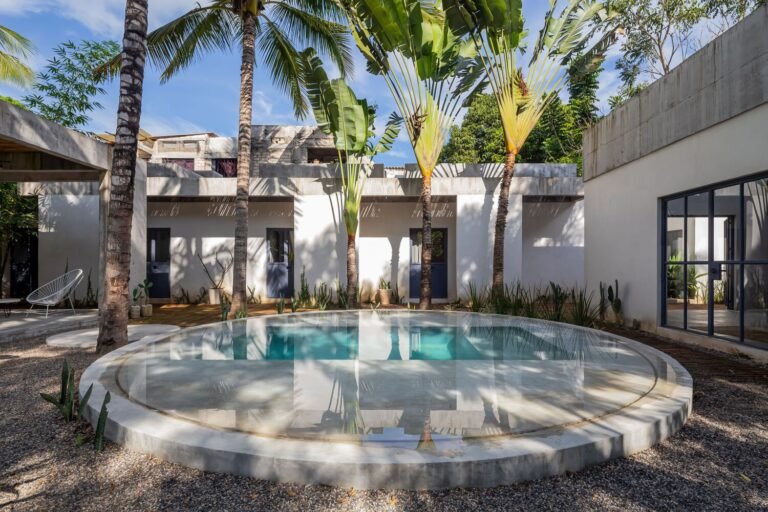Airspace Architecture: Rethinking the Hangar
Airspace Architecture: Rethinking the Hangar

Hangar architecture is a relatively new building type. Ever since the Wright brothers stored and repaired their aircraft in a wooden hangar constructed in 1902, designers and builders have continued to rethink what these structures can be. Beyond actual airports and terminals, hangars are unique in that they’re purpose-built to hold an aircraft or spacecraft. Today, how can this building type be challenged and reimagined?

The word hangar comes from Middle French hanghart, of Germanic origin. Hangars have long been built of metal, wood, or concrete, and were used for protection from the weather and direct sunlight. They were also used for maintenance, repair, manufacturing, assembly and storage of aircraft. As aviation became more established, standard designs of hangar gradually appeared across branches of the military as well. The following projects examine hangar design through adaptive reuse and modern approaches. They each represent diverse design strategies for the intersection between architecture and airspace.

Boat Hangar is a contemporary utilitarian building, both subtly referencing and sharply contrasting the rich context of the historic NDSM shipyard. BETA was charged with designing a utilitarian structure on one of the few remaining plots on the NDSM heritage site. It is used for storage, seasonal maintenance and the construction of new yachts. In addition, the building offers office space and is occasionally in use for location theatre and other cultural events at the NDSM shipyard.

House of Air, started in 2010 by two young entrepreneurs interested in the action sports world, is a trampoline facility that caters to the young, energetic and affluent population of active San Francisco. The site is at the foot of the Golden Gate Bridge and in the Golden Gate National Park, with expansive views out to the San Francisco Bay that become even more apparent when the 45′ wide glazed hanger door is opened.

The Nike Air Hangar is a 40,000 square foot facility located at the suburban Hillsboro Airport, on the outskirts of Portland. Privately owned by Nike, Inc., it houses three Gulfstream G5 jets for executive business travel. In addition to the requisite support space for flight planning and airplane maintenance, the Hangar provides amenities for travelers and pilots such as a lounge, exercise facilities, executive suites, meeting space, and a gourmet kitchen.

Expressing the innovative nature of this green research and manufacturing center and preserving the structure of the grand historic hangar that houses it is the concept behind the design of the New Lab at the Brooklyn Navy Yard. Translucent office pods stand in this 82,000 sf building in dramatic contrast to the industrial armature left visible throughout. Communal meeting rooms and interior plazas on both floors emphasize the developer’s intention to create a collaborative design and fabrication center.

MALHA was created to be an innovative platform for the fashion world. A way in which creators, entrepreneurs, producers, suppliers and consumers, committed to building a new way of operating in the fashion world, could establish connections between one another. More collaborative, local and independent, aligned with the issues involved in the debate on sustainability, new forms of consumption and environmental concerns.

The Cannes-Mandelieu Airport is one of the key points in the up-market attraction of the Côte d’Azur. Improving the services on offer for business aviation in terms of receiving air crews and effective airplane maintenance is vital for air traffic in the Nice Côte d’Azur region. The first phase of this development in the northern zone of the Cannes-Mandelieu Airport must reflect this project’s level of excellence.

The question posed by the client/artist was the possibility of a cultural island in an industrial site, the concrete fabrication of a utopic site for living, research and production. The architectural response is the result of a research towards a vocabulary of elements which could give meaning to this ambition. The cubic mass of galvanized steel in echo with the industrial façades of its environs; the monumental doors, only barely perceptible, sliding to disappear into the interior; the systematic organization of functions; the repetitively of interior grids, and the modularity of uses.

ZGF architects completed Google’s new L.A. office by transforming California’s landmark Spruce Goose Hangar. Designed as a building-within-a-building, the project was built inside the seven-story, 750-foot-long historic wooden structure. The 450,000 SF, four-level design is sited between two existing Google properties, and the project aimed to unify the Playa Vista campus while bringing a new perspective to workplace through adaptive reuse.

Secret Operation 610 is a radical mobile solution for the regeneration challenge of transforming the aircraft bunker Shelter 610 on the former American NATO Air Base Soesterberg from a F15 fighter jet hangar into a challenging experimental workspace for smaller teams. In 1994, the American troops left Air Base Soesterberg and in 2008, its aviation facilities were dismantled. Now, several years later, present owner the Province of Utrecht is giving the 500 ha terrain back to nature and to the inhabitants.






